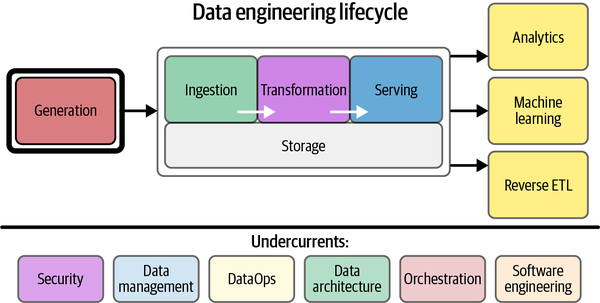Chapter 5. Data Generation in Source Systems
Welcome to the first stage of the data engineering lifecycle: data generation in source systems. As we described earlier, the job of a data engineer is to take data from source systems, do something with it, and make it helpful in serving downstream use cases. But before you get raw data, you must understand where the data exists, how it is generated, and its characteristics and quirks.
This chapter covers some popular operational source system patterns and the significant types of source systems. Many source systems exist for data generation, and we’re not exhaustively covering them all. We’ll consider the data these systems generate and things you should consider when working with source systems. We also discuss how the undercurrents of data engineering apply to this first phase of the data engineering lifecycle (Figure 5-1).

Figure 5-1. Source systems generate the data for the rest of the data engineering lifecycle
As data proliferates, especially with the rise of data sharing (discussed next), we expect that a data engineer’s role will shift heavily toward understanding the interplay between data sources and destinations. The basic plumbing tasks of data engineering—moving data from A to B—will simplify dramatically. On the other hand, it will remain critical to understand the nature of data as it’s created in source systems.
Get Fundamentals of Data Engineering now with the O’Reilly learning platform.
O’Reilly members experience books, live events, courses curated by job role, and more from O’Reilly and nearly 200 top publishers.

